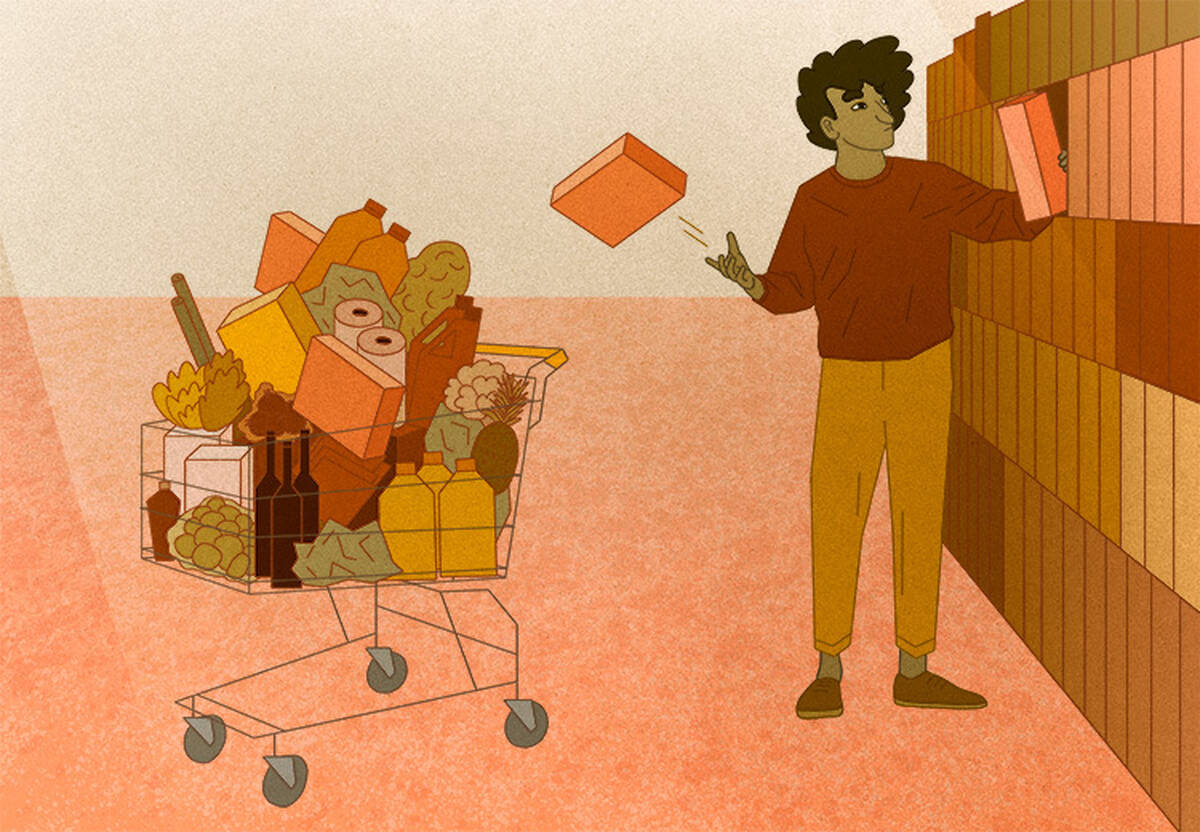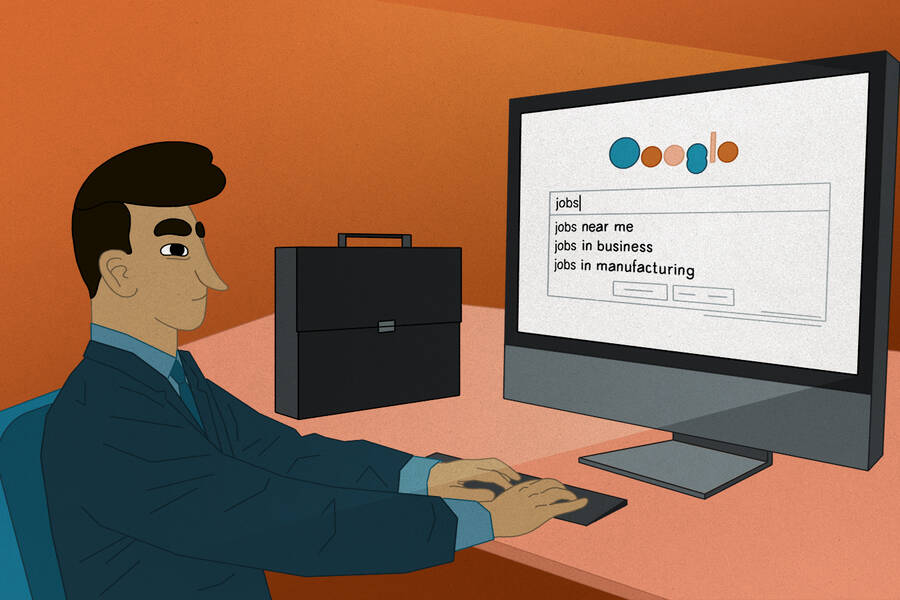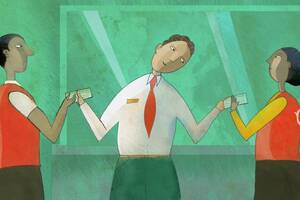Economics Apr 10, 2020
A Closer Look at Consumer Stockpiling During the Coronavirus Crisis
Researchers examined how households responded to shelter-in-place orders. They uncovered some surprises.

Lisa Röper
As the coronavirus outbreak wreaks havoc across the global economy, economists are racing to measure how economic behaviors are shifting at the household level.
Take the stockpiling of household goods, for example.
While it’s no secret that many households have been assembling vast reserves of goods like beans and toilet paper, the details of this phenomenon have been less clear. Were the spikes in spending limited to grocery items? How long are these spikes lasting? And are there patterns behind who did the most stockpiling? For instance, early polls and news reports showed that Republicans were much less concerned about the threat of the coronavirus than Democrats—so did this relative lack of concern mean they actually bought less ahead of the lockdowns?
Early answers to many of these questions are starting to emerge, thanks to a new study coauthored by Scott R. Baker, an associate professor of finance at the Kellogg School, and fellow researchers R.A. Farrokhnia and Michaela Pagel of the Columbia Business School, Constantine Yannelis at the University of Chicago’s Booth School of Business, and Steffen Meyer at the University of Southern Denmark.
The researchers’ analysis reveals several dramatic shifts in consumer behavior in recent weeks.
Americans’ overall spending jumped by a whopping 50 percent between February 26 and March 11, then sharply declined in most categories aside from grocery shopping. These spending patterns were much more pronounced in regions where residents are under stay-at-home orders; the increase in grocery spending was three times as big in such places (and the subsequent drop in overall spending was approximately twice as large).
And meaningful differences emerged along partisan lines. Contrary to what news reports might have suggested, Baker and his coauthors found that Republicans were actually somewhat more likely to stockpile than Democrats, likely because Republicans tend to have larger families, possess more resources, and be more rural.
Baker speculates that, regardless of professed concerns, most Americans feel a similar need to protect themselves and their families during a pandemic—a desire revealed by their purchasing patterns.
“Democrats and Republicans can express really different levels of worry, but some of that may be a bit performative,” Baker says. “Everyone’s behaving similarly, at least when it comes to spending their money.”
Tracking Household Spending Using Transaction Data
In no previous crisis of this scale have economists had the tools to track individuals’ spending patterns in close to real time, Baker notes.
But the researchers were able to do so thanks to an app created by a nonprofit to help users adhere to budgets. The app, which is similar to the financial-management tool Mint, allowed Baker and colleagues to access transaction-level data for 4,735 active users.
“Everyone’s behaving similarly, at least when it comes to spending their money.”
Such detailed, granular, transaction-level spending data—which wouldn’t have been available even five to ten years ago—are incredibly useful in understanding rapid changes in consumer behavior.
“Shifts can happen very quickly,” Baker says. “It’s nice to be able to see that at a really granular level, rather than looking at, say, aggregate annual data, which can obscure some of that.”
The nonprofit’s user data included some de-identified personal descriptors, including age, family size, education level, presence of children in the household, and zip code. But the data did not identify users’ political party. To get around this problem, the researchers developed a model to predict party affiliation based on a number of demographic and geographic factors found to be salient by Gallup, the public-opinion pollster.
Trends in Spending and Stockpiling During the Coronavirus Crisis
As of March 26, 21 states had announced orders to stay at home, and another 14 had such orders in some part of the state. The researchers’ analysis of Americans’ spending revealed that, by and large, individuals across the country were most likely to stock up between late February and mid-March, just before most shelter-in-place orders took effect.
While much of this stockpiling was in places where a lockdown was imminent, similar trends were seen in places where no shelter-in-place order was issued, perhaps because people anticipated a formal lockdown being imposed in their state or city soon.
Baker emphasizes that the initial uptick was hardly limited to the grocery store. Categories such as travel and retail also jumped, as people bought plane tickets to return home in time to hunker down, purchased what they needed to establish home offices, and filled closets with baby supplies and paper goods. Even restaurant spending increased, as people treated themselves to what seemed likely to be the last meal out for an indeterminate stretch of time.
However, in the second half of March, as more of the country settled into their stay-at-home reality, spending dropped precipitously.
The decrease was sharpest in states with shelter-in-place orders in effect. Restaurants were among the businesses hit hardest. Despite the availability of delivery and takeout options, residents living under shelter-in-place orders cut restaurant spending by about 32 percent, while those living in other states only cut down on this category by 12 percent.
“Temporary stimulus is going to be pretty important to keep some people’s heads above water.”
The researchers also noted differences in spending among demographic groups. The spending patterns of men and of younger people displayed more muted peaks and drop-offs. “It’s possible men and young people weren’t being as serious about it,” Baker speculates.
While both presumed Democrats and Republicans increased their spending in late February and early March, the analysis revealed that presumed Republicans had slightly larger increases in spending across most categories—and this was especially true when it came to groceries. Baker notes that Republicans tend to be older, wealthier, and have bigger families, which could help explain why their stockpiling outpaced that of presumed Democrats.
And while the general stockpiling and subsequent spending decline occurred across people of all income levels, the researchers did see a difference when they compared people with more savings to those with less. Individuals with less, or no, savings were much less likely to stockpile, they discovered.
“It’s showing that if you didn’t have much money to spend, you weren’t able to go and buy the two weeks of groceries that were recommended,” Baker explains.
By Promoting Household Spending, the Government Can Help the Economy
What does this mean for public policy, as the federal and local governments rush to buoy the economy?
Baker says his team’s findings point to the effectiveness of temporary stimulus checks, like those that the federal government has committed to sending to many Americans. And they highlight the outsize importance of making sure that significant portions of such benefits are channeled to people whose lack of savings has left them constrained (which Baker says the current stimulus will likely do).
“It’s probably a good idea to target some of this temporary release to folks who might have lower levels of liquidity,” he explains. “Temporary stimulus is going to be pretty important to keep some people’s heads above water.”
The researchers are planning follow-up projects that will examine how people spend those checks, as well as how persistent the spending changes forced by the coronavirus crisis will prove to be.
“This is a very different sort of recession than previous recessions,” Baker says. “Where previous recessions have been characterized by a shortfall in demand, here it’s more of a shortfall in supply. With businesses shut, manufacturing shut, retail shut, and entertainment shut, it’ll be interesting to see where people spend this money. If this goes on for months and people change their spending habits, this really has the potential to change the economic landscape for firms.”



